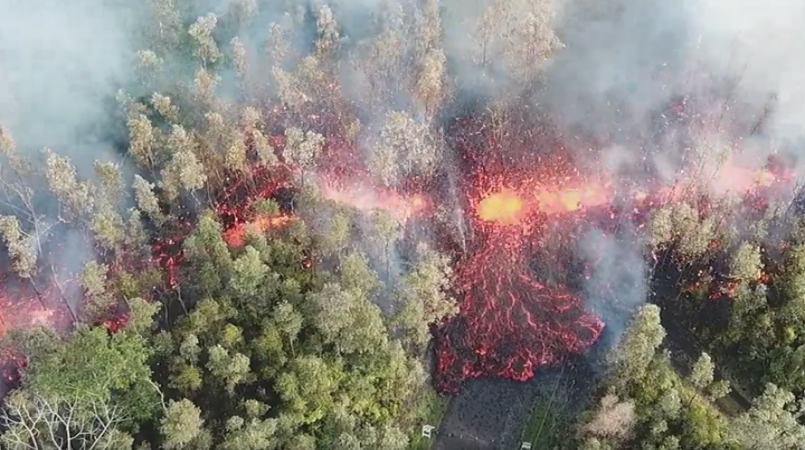
Fresh eruptions sending fountains of lava 30m out of the ground have taken place on Hawaii's Big Island, destroying several homes.
The Civil Defense Agency said there were fissures on three streets and told any remaining residents to evacuate.
It said there were deadly levels of dangerous sulphur dioxide gas in the air and emergency crews would not be able to help anyone affected.
The new activity comes a day after Kilauea volcano erupted.
A number of increasingly strong earthquakes rocked the area after the eruption, with a 6.9 magnitude quake reportedly occurring south of the volcano.
The Pacific Tsunami Warning Center tweeted that there was no tsunami threat from the quake.
A New Zealand Civil Defence spokesperson said they are monitoring the situation in Hawaii.
However, said there is no tsunami warning or expectations at this stage that it will impact New Zealand.
The new volcanic activity in Mt Kilauea's lower east rift zone amounted to "vigorous lava spattering", the US Geological Survey (USGS) said, adding that additional outbreaks in the area were likely.
The lava was not travelling more than a "few tens of yards" from the vents, which were on streets in the Leilani Estates neighbourhood near Big Island's eastern tip, the USGS said.
However ground deformation was continuing and there was high earthquake activity in the area, it said. Meanwhile the level of the lava lake inside the volcano was continuing to drop.
New Zealand Volcanologist Brad Scott said this particular eruptive episode first began in the 1970s.
"So this is a very long term, long lived eruptive episode for Hawaii," he said.
He added large earthquakes with rift eruptions are not uncommon.
Mr Scott said the volcanoes don't tend to form much ash, but they do produce VOG or volcanic gas.
"The volcanic gases are generally more of an irritant and a nuisance, they're certainly of signifance for people who have got a respiratory ailment already, they'll trigger off asthmatic attacks and things like that," he said.
The changes have been seen by the volcanic observatory, especially over the last couple of weeks, said Mr Scott.
"They've been issuing warnings, so it's not a blue sky eruption or unexpected at all," he said.
Two homes had been destroyed in the latest activity, ABC quoted Hawaii island Mayor Harry Kim as saying.
Residents described fleeing their homes on Thursday evening.
"My family is safe, the rest of the stuff can be replaced. When I bought here 14 years [ago], I knew that this day would eventually come. But the reality is sinking in now," one resident told Hawaii News Now.
Thursday's eruption prompted a local state of emergency and the mandatory evacuation of 1,700 residents.
Community centres have been opened to provide shelter for evacuees.
Kilauea is one of the world's most active volcanoes and the eruption follows a series of recent earthquakes.
Officials had been warning residents all week they should be prepared to evacuate as an eruption would give little warning.
A volcanic crater vent - known as Puu Oo - collapsed earlier this week, sending lava down the mountain's slopes towards populated areas.
Hawaii's Governor, David Ige, said he had activated military reservists from the National Guard to help evacuate thousands of people.
Close-up footage shot by a drone showed lava emerging from a fissure in a wooded residential neighbourhood and oozing down a road.
Earlier this year, a false alert warning of an incoming ballistic missile caused panic, leading the US state to reassess its alert system.
